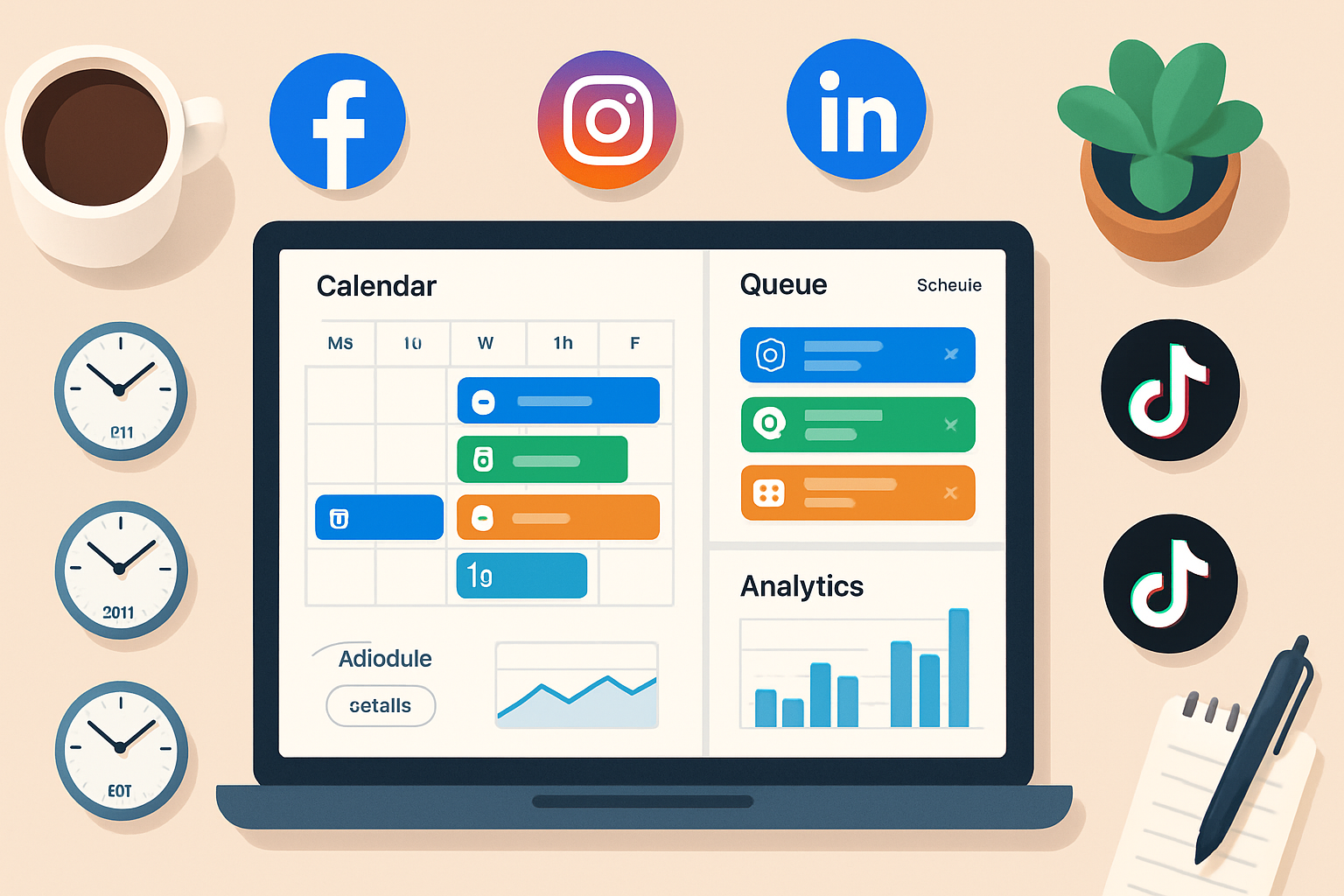· business · 6 min read
Maximizing Engagement: How to Use Hootsuite's Analytics to Drive Real-Time Results
Learn how to use Hootsuite's analytics features to find peak engagement times, optimize content in real time, set up custom reports, and run data-driven experiments - with step-by-step instructions and case studies.

Outcome-first: in 8 weeks you can uncover the hours that actually move your audience, increase reach, and turn social engagement into measurable results. Read on to learn the exact Hootsuite analytics workflows, report templates, and real-time tactics that make it possible.
Why Hootsuite Analytics matters - and what you’ll get from this guide
Good analytics don’t just tell you what happened. They tell you what to do next. With Hootsuite’s analytics and its real-time streams you can:
- Discover the exact hours and days when your audience engages most.
- Optimize content mix (image, video, link) to maximize reach and shares.
- Detect engagement spikes and respond immediately to capture momentum.
- Turn top organic posts into high-performing paid campaigns using UTM tracking and conversion metrics.
This guide gives step-by-step instructions, metric definitions, a 30-day test workflow, report templates, and two practical case studies (composite examples) to model.
Before you start: define success and connect the data
Outcome-first planning saves time. Decide your primary KPI before you dig into Hootsuite: reach, engagement rate, clicks, or conversions. Then take these setup steps:
- Choose KPIs. (Example - Increase weekly post engagement rate by 25%.)
- Connect every social profile you want to measure (Twitter/X, Facebook, LinkedIn, Instagram, TikTok, YouTube).
- Link Google Analytics and add UTM parameters for campaign-level tracking. See Hootsuite’s UTM setup guide: https://help.hootsuite.com/hc/en-us/articles/204598170-Track-UTM-parameters-in-your-URLs
- Confirm permissions so your team can create and export custom reports.
If your objective is real-time reaction (customer service, product launch), add streams for mentions, comments, and relevant search terms in the Hootsuite dashboard.
Step-by-step: find peak engagement times with Hootsuite
- Open Hootsuite Analytics and pick the profiles you want to analyze.
- Set a meaningful date range - at least 30 days, ideally 90 days to capture weekly cycles. Compare to the previous period for trend context.
- Use the “Top Posts” or “Post Performance” view to surface posts sorted by engagement, reach, or clicks.
- Drill into post timestamps. Export results if you need to manipulate data in Excel or Google Sheets.
- Create an “Engagement by Day/Hour” heatmap. In Hootsuite you can use built-in time analysis widgets or export timestamps and pivot by day/hour. Look for repeated high-density squares - those are your peaks.
- Convert top-performing time windows into publishing slots in Hootsuite Planner or AutoSchedule.
Quick tip: measure engagement relative to audience size. Use engagement rate (below) rather than raw likes or comments.
Engagement rate formulas (use whichever suits your reporting)
- Engagement rate (per impression) - (Likes + Comments + Shares) / Impressions
- Engagement rate (per follower) - (Likes + Comments + Shares) / Followers
Example code block for a quick spreadsheet formula:
EngagementRate = (Likes + Comments + Shares) / ImpressionsOptimize content for those peak times
Once you identify peak windows, don’t just post the same content at those times. Run focused experiments:
- A/B test formats - image vs. short video vs. carousel.
- Test copy length - short hook vs. longer explanation.
- Test CTA placement and link types (direct link vs. landing page with UTM).
Use Hootsuite’s post performance metrics to compare reach, impressions, clicks, and engagement rate for each variation. Keep tests simple: change one variable at a time.
Real-time monitoring and immediate actions
Hootsuite’s streams are your real-time nerve center. Steps:
- Create streams for - mentions, messages, comments, and search terms tied to your campaign.
- Add a stream for competitor keywords and branded hashtags.
- Monitor engagement spikes - sudden jumps in mentions or shares signal an opportunity.
- When a spike appears - prioritize a fast, human reply where appropriate, pin or boost the organic post, and consider converting the post into a paid ad.
Action playbook for a spike:
- Within 15 minutes - reply to top comments and highlight community sentiment.
- Within 1 hour - pin the post (or resurface in high-visibility channels) and set the post as an ad candidate.
- Within 24 hours - run a quick paid test with the same creative targeted to the engaged audience.
Build high-impact custom reports (templates you can reuse)
Create two report types: Executive (weekly) and Tactical (daily/real-time).
Executive report - weekly PDF to stakeholders:
- Summary - total reach, impressions, engagement rate, clicks, conversions.
- Top 5 posts (with creative thumbnails and key metrics).
- Best time-to-publish recommendation (heatmap snapshot).
- Top converting posts (UTM-tagged).
- Actions taken and next steps.
Tactical report - daily/real-time dashboard for the social team:
- Mentions and sentiment.
- Live engagement rate by profile.
- Engagement by hour heatmap.
- Alerts for spikes (set thresholds).
- Top posts in the last 24 hours.
Automate delivery: use Hootsuite’s scheduled report export to email PDFs or CSVs to your team at set intervals.
Hootsuite Analytics help: https://help.hootsuite.com/hc/en-us/articles/360000492627-Analytics-overview
Integrate with conversion tracking and paid promotion
Link organic performance to business outcomes by combining Hootsuite analytics with Google Analytics (or your preferred analytics tool). Steps:
- Use consistent UTM tags on social links.
- Monitor campaign landing pages in Google Analytics to measure sessions, goal completions, and conversion rate.
- Identify top organic posts in Hootsuite and create corresponding paid campaigns using the same creative and audience.
- Compare CPA and conversion rate between organic-driven paid tests and control ads.
Google’s UTM primer is a solid reference: https://support.google.com/analytics/answer/1033863
30-day test workflow (practical template)
Week 0 - Setup
- Connect profiles, enable streams, set KPIs, implement UTMs.
- Export 90 days of historical data if available.
Week 1 - Discovery
- Run an initial analysis - top posts, heatmap, and baseline engagement rates.
- Pick 2–3 peak windows and 2–3 off-peak windows for contrast.
Weeks 2–3 - Experiment
- Schedule identical posts (format A vs. B) across peak and off-peak windows.
- Track reach, impressions, clicks, and conversions.
- Make no more than one variable change per experiment.
Week 4 - Evaluate and act
- Use Hootsuite reports to compare results and declare winners.
- Reallocate organic publishing calendar and scale winning content into paid campaigns.
- Set up automated reports for your next cycle.
Two short case studies (composite examples)
Case Study: Retail brand (composite)
- Goal - increase social-driven website traffic and improve engagement.
- What they did - used Hootsuite analytics to identify a 6–9 PM weekday engagement peak, then A/B tested lifestyle photo versus short product video during that window.
- Result - product video at 7 PM outperformed photo by 42% higher engagement rate and 30% more clicks. Turned top-performing video into a paid campaign and saw a 25% lower CPC vs. baseline.
Case Study: B2B SaaS (composite)
- Goal - increase demo signups from LinkedIn.
- What they did - added UTM tracking, used Hootsuite to find that posts Monday 10–11 AM had the highest CTR, and tested long-form post vs. short CTA post.
- Result - long-form posts at 10:30 AM produced 60% more demo signups when combined with a tailored LinkedIn Sponsored Content test.
These are composite examples based on common outcomes from systematic testing and Hootsuite workflows.
Common pitfalls and how to avoid them
Mistake - using raw likes as your success metric.
- Fix - use engagement rate and conversions to reflect true impact.
Mistake - changing multiple variables at once during tests.
- Fix - isolate one variable per experiment.
Mistake - ignoring time-zone segmentation for international audiences.
- Fix - segment reporting by region or schedule localized posts in the audience’s time zone.
Mistake - overreacting to a single spike without context.
- Fix - verify sentiment and look for repeatable patterns before changing strategy.
Checklist: what to do this week in Hootsuite
- Connect Google Analytics and enable UTM tagging on all social links.
- Export 90 days of post data and create an engagement-by-hour heatmap.
- Schedule top 3 posts into identified peak windows and run A/B tests for format.
- Create a weekly executive report and a daily tactical dashboard.
- Set stream-based alerts for mentions and spikes.
Final notes: make real-time results repeatable
Real-time wins are valuable. But repeatable systems are what scale them. Use Hootsuite analytics to build a tested publishing calendar, automate reports, and tie organic performance to conversion metrics. Do this, and you’ll stop guessing when to post - and start reliably driving results.
References
- Hootsuite Analytics Overview: https://help.hootsuite.com/hc/en-us/articles/360000492627-Analytics-overview
- Hootsuite UTM tracking guide: https://help.hootsuite.com/hc/en-us/articles/204598170-Track-UTM-parameters-in-your-URLs
- Google Analytics UTM guide: https://support.google.com/analytics/answer/1033863



